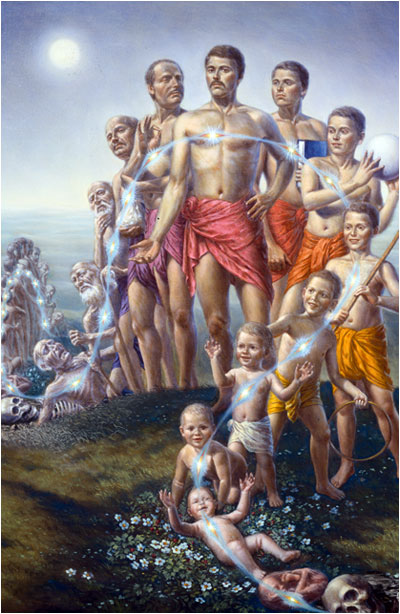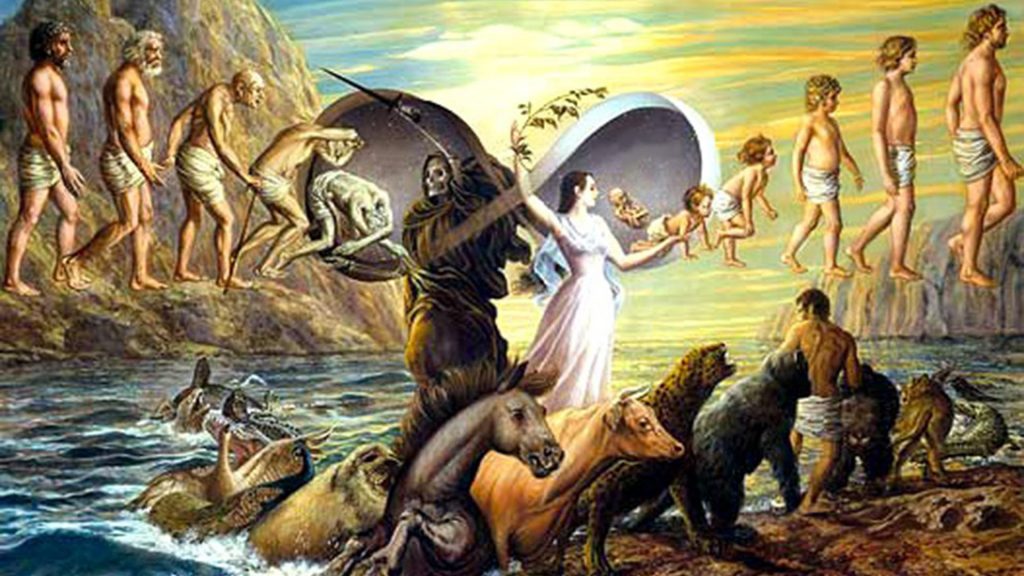Life After Death – Once on a sea beach, a person named Gopal got swayed into the sea and was drowning. When he asked for help, the nearby fisherman dived in to search for him. Instead of saving the drowning person Gopal, he brought out the shirt of Gopal. All of us will certainly agree that the effort of the fisherman was in vain.
This simple allegory is there to illustrate that mere saving of the body will NOT save the soul. In the present day world, all are concerned about the body, which is like the shirt for the soul, while they have no concern about the soul at all. We all know that there is a difference between the living body and the dead body. A body is living because the consciousness pervades the entire body. Lord Krishna teaches us that the soul, a very tiny fragmental portion of Him, is the basis of this consciousness. A learned person must learn how to ascertain the difference between a dead body and a living body. Technically, k
nowledge starts when one introspects the difference between the spirit (soul) and the matter. As Lord Krishna affirms in Bhagavad Gita(BG) 2.17 that, it is the consciousness that pervades the whole body and is the basic principle by which a living body differs from the dead body.
avināśi tu tad viddhi
yena sarvam idaṁ tatam
vināśam avyayasyāsya
na kaścit kartum arhati
Translation: “That which pervades the entire body you should know to be indestructible. No one is able to destroy that imperishable soul.”[BG 2.17]
Table of Contents
Transmigration of the Soul
In Veda, the soul is referred to as jiva or atman. But in the impure state, the jiva is encaged in a physical body. This embodied soul is continuously migrating from one body to another including the present body. As Lord Krishna aptly states in Bhagavad Gita 2.13:
dehino ’smin yathā dehe
kaumāraṁ yauvanaṁ jarā
tathā dehāntara-prāptir
dhīras tatra na muhyati
Translation: “As the embodied soul continuously passes, in this body, from boyhood to youth to old age, the soul similarly passes into another body at death. A sober person is not bewildered by such a change.”[BG 2.13]

The figure above shows that the soul is continuously transmigrating in this very body from boyhood to youth to old age . Learned men who understand the nature of the soul do not bereave as they see death as a process in which the soul has transmigrated to a completely new body. So death is the biggest illusion for those who are ignorant. Krishna is telling this in the beginning of Bhagavad Gita because Arjun was lamenting that he has to kill his teacher and his grandfather whom he loved so much. Krishna is assuring Arjuna: “My dear friend there is nothing called death, it’s simply an illusion.”

The above figure depicts the transmigration of the soul from one body to another. Even from a human body one may transmigrate to a lower form of body such as plant, insect or animal. Now, what decides our next body? We are actually forced to take up another body according to our consciousness at the time of death.
The Subtle body carries the soul from one body to another
The body in which the soul resides may be divided into two categories: one is the gross body (consisting of earth, water, fire, air, ether) and another is subtle body (consisting of mind, intelligence and false ego). As we transmigrate from one body to another body, only the gross body perishes. The subtle body carries us from one body to another. We do not change our mind, our intellect and our false ego. These three things we always carry. You must have seen that when a child grows, he manifests certain behaviour. We see some children are very peaceful yet others are very naughty. It is not that somebody has taught them how to become naughty. As the body grows, many traits that manifest in the gross body are derived from the subtle body.

Gopal and Ram are twins.Yet, later Gopal goes on to become a professor in a reputed university while Ram excels in fine-arts.
You will find such examples aplenty. Besides the environment, the gross body is influence by the subtle body. So the mind, intellect and false ego are always with the soul. Once soul becomes detach from mind, intellect and false ego, then it is liberate. At that state, one can see Krishna directly. The process of liberation is to become dissociate from both gross and subtle bodies while getting fully attach to Lord Krishna. This is the basic instruction in Bhagavad Gita.
When death comes, all our subtle desires dissolve in our mind, and that mind carries us to a new body. Just like the air carries aroma of a flower from one place to the other, the subtle body carries the soul from one body to the other. This is the reason why different people have different desires. Even if two brothers are born in the same family, they will develop different tastes because they are carrying their own karma/ own impressions with them. This mind is different from the mind of the soul. So the physical mind and the mind of the soul are different. Soul has its own spiritual body comprising mind, ears, eyes, heart, and other organs.
The material mind, intellect and false ego are the part of the subtle body while earth, water, fire, air, and ether constitute the gross body. We need to transcend our experiences beyond these gross and subtle bodies to be able to experience ourselves (the soul). That is why Lord Krishna concludes the description of the soul as:
āścarya-vat paśyati kaścid enam
āścarya-vad vadati tathaiva cānyaḥ
āścarya-vac cainam anyaḥ śṛṇoti
śrutvāpy enaṁ veda na caiva kaścit
Translation: “Some look on the soul as amazing, some describe him as amazing, and some hear of him as amazing, while others, even after hearing about him, cannot understand him at all.”[Bg 2.29]

